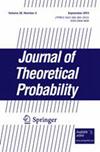求助PDF
{"title":"具有固定边际分布的随机向量的均值分布","authors":"Andrzej Komisarski, Jacques Labuschagne","doi":"10.1007/s10959-023-01277-2","DOIUrl":null,"url":null,"abstract":"Abstract Using recent results concerning non-uniqueness of the center of the mix for completely mixable probability distributions, we obtain the following result: For each $$d\\in {\\mathbb {N}}$$ <mml:math xmlns:mml=\"http://www.w3.org/1998/Math/MathML\"> <mml:mrow> <mml:mi>d</mml:mi> <mml:mo>∈</mml:mo> <mml:mi>N</mml:mi> </mml:mrow> </mml:math> and each non-empty bounded Borel set $$B\\subset {\\mathbb {R}}^d$$ <mml:math xmlns:mml=\"http://www.w3.org/1998/Math/MathML\"> <mml:mrow> <mml:mi>B</mml:mi> <mml:mo>⊂</mml:mo> <mml:msup> <mml:mrow> <mml:mi>R</mml:mi> </mml:mrow> <mml:mi>d</mml:mi> </mml:msup> </mml:mrow> </mml:math> , there exists a d -dimensional probability distribution $$\\varvec{\\mu }$$ <mml:math xmlns:mml=\"http://www.w3.org/1998/Math/MathML\"> <mml:mrow> <mml:mi>μ</mml:mi> </mml:mrow> </mml:math> satisfying the following: For each $$n\\ge 3$$ <mml:math xmlns:mml=\"http://www.w3.org/1998/Math/MathML\"> <mml:mrow> <mml:mi>n</mml:mi> <mml:mo>≥</mml:mo> <mml:mn>3</mml:mn> </mml:mrow> </mml:math> and each probability distribution $$\\varvec{\\nu }$$ <mml:math xmlns:mml=\"http://www.w3.org/1998/Math/MathML\"> <mml:mrow> <mml:mi>ν</mml:mi> </mml:mrow> </mml:math> on B , there exist d -dimensional random vectors $${\\textbf{X}}_{\\varvec{\\nu },1},{\\textbf{X}}_{\\varvec{\\nu },2},\\dots ,{\\textbf{X}}_{\\varvec{\\nu },n}$$ <mml:math xmlns:mml=\"http://www.w3.org/1998/Math/MathML\"> <mml:mrow> <mml:msub> <mml:mi>X</mml:mi> <mml:mrow> <mml:mrow> <mml:mi>ν</mml:mi> </mml:mrow> <mml:mo>,</mml:mo> <mml:mn>1</mml:mn> </mml:mrow> </mml:msub> <mml:mo>,</mml:mo> <mml:msub> <mml:mi>X</mml:mi> <mml:mrow> <mml:mrow> <mml:mi>ν</mml:mi> </mml:mrow> <mml:mo>,</mml:mo> <mml:mn>2</mml:mn> </mml:mrow> </mml:msub> <mml:mo>,</mml:mo> <mml:mo>⋯</mml:mo> <mml:mo>,</mml:mo> <mml:msub> <mml:mi>X</mml:mi> <mml:mrow> <mml:mrow> <mml:mi>ν</mml:mi> </mml:mrow> <mml:mo>,</mml:mo> <mml:mi>n</mml:mi> </mml:mrow> </mml:msub> </mml:mrow> </mml:math> such that $$\\frac{1}{n}({\\textbf{X}}_{\\varvec{\\nu },1}+{\\textbf{X}}_{\\varvec{\\nu },2}+\\dots +{\\textbf{X}}_{\\varvec{\\nu },n})\\sim \\varvec{\\nu }$$ <mml:math xmlns:mml=\"http://www.w3.org/1998/Math/MathML\"> <mml:mrow> <mml:mfrac> <mml:mn>1</mml:mn> <mml:mi>n</mml:mi> </mml:mfrac> <mml:mrow> <mml:mo>(</mml:mo> <mml:msub> <mml:mi>X</mml:mi> <mml:mrow> <mml:mrow> <mml:mi>ν</mml:mi> </mml:mrow> <mml:mo>,</mml:mo> <mml:mn>1</mml:mn> </mml:mrow> </mml:msub> <mml:mo>+</mml:mo> <mml:msub> <mml:mi>X</mml:mi> <mml:mrow> <mml:mrow> <mml:mi>ν</mml:mi> </mml:mrow> <mml:mo>,</mml:mo> <mml:mn>2</mml:mn> </mml:mrow> </mml:msub> <mml:mo>+</mml:mo> <mml:mo>⋯</mml:mo> <mml:mo>+</mml:mo> <mml:msub> <mml:mi>X</mml:mi> <mml:mrow> <mml:mrow> <mml:mi>ν</mml:mi> </mml:mrow> <mml:mo>,</mml:mo> <mml:mi>n</mml:mi> </mml:mrow> </mml:msub> <mml:mo>)</mml:mo> </mml:mrow> <mml:mo>∼</mml:mo> <mml:mrow> <mml:mi>ν</mml:mi> </mml:mrow> </mml:mrow> </mml:math> and $${\\textbf{X}}_{\\varvec{\\nu },i}\\sim \\varvec{\\mu }$$ <mml:math xmlns:mml=\"http://www.w3.org/1998/Math/MathML\"> <mml:mrow> <mml:msub> <mml:mi>X</mml:mi> <mml:mrow> <mml:mrow> <mml:mi>ν</mml:mi> </mml:mrow> <mml:mo>,</mml:mo> <mml:mi>i</mml:mi> </mml:mrow> </mml:msub> <mml:mo>∼</mml:mo> <mml:mrow> <mml:mi>μ</mml:mi> </mml:mrow> </mml:mrow> </mml:math> for $$i=1,2,\\dots ,n$$ <mml:math xmlns:mml=\"http://www.w3.org/1998/Math/MathML\"> <mml:mrow> <mml:mi>i</mml:mi> <mml:mo>=</mml:mo> <mml:mn>1</mml:mn> <mml:mo>,</mml:mo> <mml:mn>2</mml:mn> <mml:mo>,</mml:mo> <mml:mo>⋯</mml:mo> <mml:mo>,</mml:mo> <mml:mi>n</mml:mi> </mml:mrow> </mml:math> . We also show that the assumption regarding the boundedness of the set B cannot be completely omitted, but it can be substantially weakened.","PeriodicalId":54760,"journal":{"name":"Journal of Theoretical Probability","volume":"23 1","pages":"0"},"PeriodicalIF":0.6000,"publicationDate":"2023-09-25","publicationTypes":"Journal Article","fieldsOfStudy":null,"isOpenAccess":false,"openAccessPdf":"","citationCount":"0","resultStr":"{\"title\":\"The Distributions of the Mean of Random Vectors with Fixed Marginal Distribution\",\"authors\":\"Andrzej Komisarski, Jacques Labuschagne\",\"doi\":\"10.1007/s10959-023-01277-2\",\"DOIUrl\":null,\"url\":null,\"abstract\":\"Abstract Using recent results concerning non-uniqueness of the center of the mix for completely mixable probability distributions, we obtain the following result: For each $$d\\\\in {\\\\mathbb {N}}$$ <mml:math xmlns:mml=\\\"http://www.w3.org/1998/Math/MathML\\\"> <mml:mrow> <mml:mi>d</mml:mi> <mml:mo>∈</mml:mo> <mml:mi>N</mml:mi> </mml:mrow> </mml:math> and each non-empty bounded Borel set $$B\\\\subset {\\\\mathbb {R}}^d$$ <mml:math xmlns:mml=\\\"http://www.w3.org/1998/Math/MathML\\\"> <mml:mrow> <mml:mi>B</mml:mi> <mml:mo>⊂</mml:mo> <mml:msup> <mml:mrow> <mml:mi>R</mml:mi> </mml:mrow> <mml:mi>d</mml:mi> </mml:msup> </mml:mrow> </mml:math> , there exists a d -dimensional probability distribution $$\\\\varvec{\\\\mu }$$ <mml:math xmlns:mml=\\\"http://www.w3.org/1998/Math/MathML\\\"> <mml:mrow> <mml:mi>μ</mml:mi> </mml:mrow> </mml:math> satisfying the following: For each $$n\\\\ge 3$$ <mml:math xmlns:mml=\\\"http://www.w3.org/1998/Math/MathML\\\"> <mml:mrow> <mml:mi>n</mml:mi> <mml:mo>≥</mml:mo> <mml:mn>3</mml:mn> </mml:mrow> </mml:math> and each probability distribution $$\\\\varvec{\\\\nu }$$ <mml:math xmlns:mml=\\\"http://www.w3.org/1998/Math/MathML\\\"> <mml:mrow> <mml:mi>ν</mml:mi> </mml:mrow> </mml:math> on B , there exist d -dimensional random vectors $${\\\\textbf{X}}_{\\\\varvec{\\\\nu },1},{\\\\textbf{X}}_{\\\\varvec{\\\\nu },2},\\\\dots ,{\\\\textbf{X}}_{\\\\varvec{\\\\nu },n}$$ <mml:math xmlns:mml=\\\"http://www.w3.org/1998/Math/MathML\\\"> <mml:mrow> <mml:msub> <mml:mi>X</mml:mi> <mml:mrow> <mml:mrow> <mml:mi>ν</mml:mi> </mml:mrow> <mml:mo>,</mml:mo> <mml:mn>1</mml:mn> </mml:mrow> </mml:msub> <mml:mo>,</mml:mo> <mml:msub> <mml:mi>X</mml:mi> <mml:mrow> <mml:mrow> <mml:mi>ν</mml:mi> </mml:mrow> <mml:mo>,</mml:mo> <mml:mn>2</mml:mn> </mml:mrow> </mml:msub> <mml:mo>,</mml:mo> <mml:mo>⋯</mml:mo> <mml:mo>,</mml:mo> <mml:msub> <mml:mi>X</mml:mi> <mml:mrow> <mml:mrow> <mml:mi>ν</mml:mi> </mml:mrow> <mml:mo>,</mml:mo> <mml:mi>n</mml:mi> </mml:mrow> </mml:msub> </mml:mrow> </mml:math> such that $$\\\\frac{1}{n}({\\\\textbf{X}}_{\\\\varvec{\\\\nu },1}+{\\\\textbf{X}}_{\\\\varvec{\\\\nu },2}+\\\\dots +{\\\\textbf{X}}_{\\\\varvec{\\\\nu },n})\\\\sim \\\\varvec{\\\\nu }$$ <mml:math xmlns:mml=\\\"http://www.w3.org/1998/Math/MathML\\\"> <mml:mrow> <mml:mfrac> <mml:mn>1</mml:mn> <mml:mi>n</mml:mi> </mml:mfrac> <mml:mrow> <mml:mo>(</mml:mo> <mml:msub> <mml:mi>X</mml:mi> <mml:mrow> <mml:mrow> <mml:mi>ν</mml:mi> </mml:mrow> <mml:mo>,</mml:mo> <mml:mn>1</mml:mn> </mml:mrow> </mml:msub> <mml:mo>+</mml:mo> <mml:msub> <mml:mi>X</mml:mi> <mml:mrow> <mml:mrow> <mml:mi>ν</mml:mi> </mml:mrow> <mml:mo>,</mml:mo> <mml:mn>2</mml:mn> </mml:mrow> </mml:msub> <mml:mo>+</mml:mo> <mml:mo>⋯</mml:mo> <mml:mo>+</mml:mo> <mml:msub> <mml:mi>X</mml:mi> <mml:mrow> <mml:mrow> <mml:mi>ν</mml:mi> </mml:mrow> <mml:mo>,</mml:mo> <mml:mi>n</mml:mi> </mml:mrow> </mml:msub> <mml:mo>)</mml:mo> </mml:mrow> <mml:mo>∼</mml:mo> <mml:mrow> <mml:mi>ν</mml:mi> </mml:mrow> </mml:mrow> </mml:math> and $${\\\\textbf{X}}_{\\\\varvec{\\\\nu },i}\\\\sim \\\\varvec{\\\\mu }$$ <mml:math xmlns:mml=\\\"http://www.w3.org/1998/Math/MathML\\\"> <mml:mrow> <mml:msub> <mml:mi>X</mml:mi> <mml:mrow> <mml:mrow> <mml:mi>ν</mml:mi> </mml:mrow> <mml:mo>,</mml:mo> <mml:mi>i</mml:mi> </mml:mrow> </mml:msub> <mml:mo>∼</mml:mo> <mml:mrow> <mml:mi>μ</mml:mi> </mml:mrow> </mml:mrow> </mml:math> for $$i=1,2,\\\\dots ,n$$ <mml:math xmlns:mml=\\\"http://www.w3.org/1998/Math/MathML\\\"> <mml:mrow> <mml:mi>i</mml:mi> <mml:mo>=</mml:mo> <mml:mn>1</mml:mn> <mml:mo>,</mml:mo> <mml:mn>2</mml:mn> <mml:mo>,</mml:mo> <mml:mo>⋯</mml:mo> <mml:mo>,</mml:mo> <mml:mi>n</mml:mi> </mml:mrow> </mml:math> . We also show that the assumption regarding the boundedness of the set B cannot be completely omitted, but it can be substantially weakened.\",\"PeriodicalId\":54760,\"journal\":{\"name\":\"Journal of Theoretical Probability\",\"volume\":\"23 1\",\"pages\":\"0\"},\"PeriodicalIF\":0.6000,\"publicationDate\":\"2023-09-25\",\"publicationTypes\":\"Journal Article\",\"fieldsOfStudy\":null,\"isOpenAccess\":false,\"openAccessPdf\":\"\",\"citationCount\":\"0\",\"resultStr\":null,\"platform\":\"Semanticscholar\",\"paperid\":null,\"PeriodicalName\":\"Journal of Theoretical Probability\",\"FirstCategoryId\":\"1085\",\"ListUrlMain\":\"https://doi.org/10.1007/s10959-023-01277-2\",\"RegionNum\":4,\"RegionCategory\":\"数学\",\"ArticlePicture\":[],\"TitleCN\":null,\"AbstractTextCN\":null,\"PMCID\":null,\"EPubDate\":\"\",\"PubModel\":\"\",\"JCR\":\"Q3\",\"JCRName\":\"STATISTICS & PROBABILITY\",\"Score\":null,\"Total\":0}","platform":"Semanticscholar","paperid":null,"PeriodicalName":"Journal of Theoretical Probability","FirstCategoryId":"1085","ListUrlMain":"https://doi.org/10.1007/s10959-023-01277-2","RegionNum":4,"RegionCategory":"数学","ArticlePicture":[],"TitleCN":null,"AbstractTextCN":null,"PMCID":null,"EPubDate":"","PubModel":"","JCR":"Q3","JCRName":"STATISTICS & PROBABILITY","Score":null,"Total":0}
引用次数: 0
引用
批量引用
The Distributions of the Mean of Random Vectors with Fixed Marginal Distribution
Abstract Using recent results concerning non-uniqueness of the center of the mix for completely mixable probability distributions, we obtain the following result: For each $$d\in {\mathbb {N}}$$ d ∈ N and each non-empty bounded Borel set $$B\subset {\mathbb {R}}^d$$ B ⊂ R d , there exists a d -dimensional probability distribution $$\varvec{\mu }$$ μ satisfying the following: For each $$n\ge 3$$ n ≥ 3 and each probability distribution $$\varvec{\nu }$$ ν on B , there exist d -dimensional random vectors $${\textbf{X}}_{\varvec{\nu },1},{\textbf{X}}_{\varvec{\nu },2},\dots ,{\textbf{X}}_{\varvec{\nu },n}$$ X ν , 1 , X ν , 2 , ⋯ , X ν , n such that $$\frac{1}{n}({\textbf{X}}_{\varvec{\nu },1}+{\textbf{X}}_{\varvec{\nu },2}+\dots +{\textbf{X}}_{\varvec{\nu },n})\sim \varvec{\nu }$$ 1 n ( X ν , 1 + X ν , 2 + ⋯ + X ν , n ) ∼ ν and $${\textbf{X}}_{\varvec{\nu },i}\sim \varvec{\mu }$$ X ν , i ∼ μ for $$i=1,2,\dots ,n$$ i = 1 , 2 , ⋯ , n . We also show that the assumption regarding the boundedness of the set B cannot be completely omitted, but it can be substantially weakened.

 求助内容:
求助内容: 应助结果提醒方式:
应助结果提醒方式:


